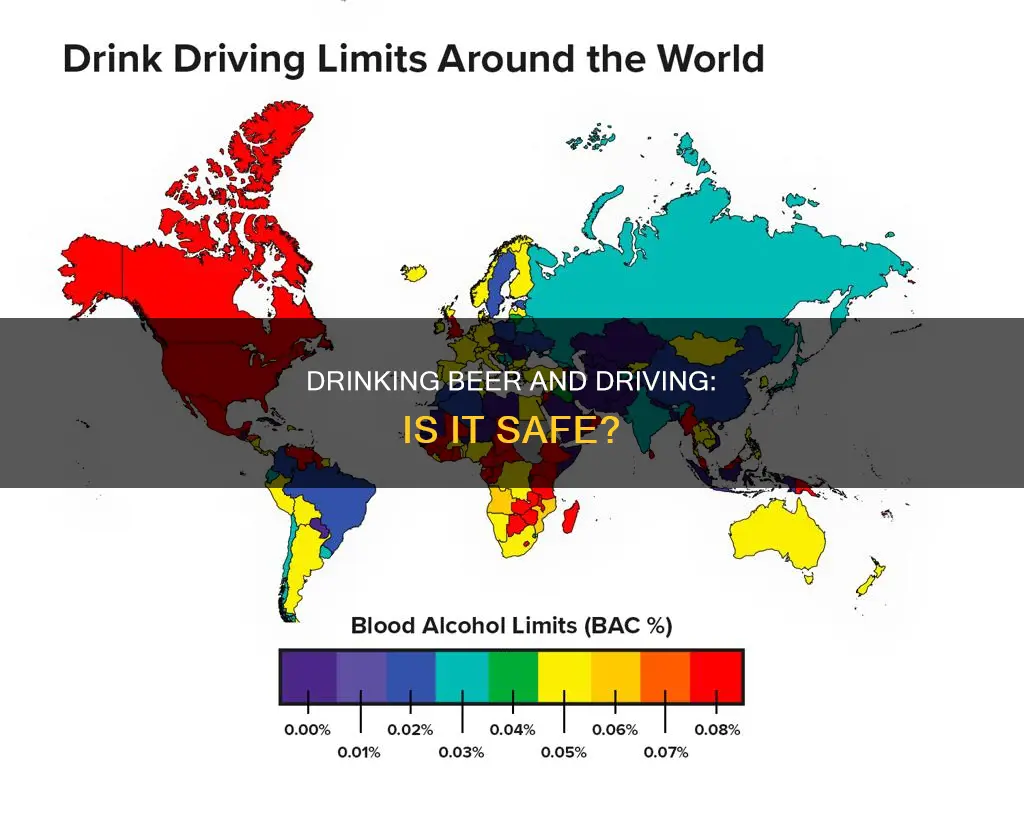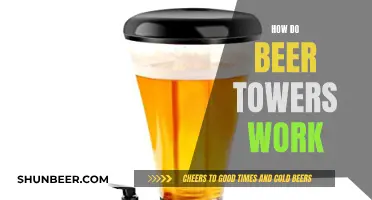
Drinking and driving is a dangerous combination. Alcohol affects your judgement, slows your reaction time, and impairs your ability to focus, control the car, and coordinate your movements. Even small amounts of alcohol can increase your risk of accidents and DUI. While one to two drinks may keep you below the legal limit, any amount of alcohol can impact your driving ability. The safest option is to avoid driving if you've been drinking and to take public transportation or a rideshare instead.
| Characteristics | Values |
|---|---|
| Number of beers that can be consumed before driving | This varies depending on factors such as weight, gender, metabolic rate, and the alcohol by volume (ABV) of the beer. For example, a 180-lb man may be able to drink 3.5 regular 12-ounce beers in one hour and keep his Blood Alcohol Concentration (BAC) under the legal limit of .08%. Similarly, a 140-lb woman may be able to consume 2.5 regular beers in an hour and maintain a BAC of less than .08%. |
| Legal limit of Blood Alcohol Concentration (BAC) | The legal limit is 0.08% BAC. However, it is important to note that any amount of alcohol can impact driving ability and increase the risk of accidents and DUIs. |
| Effects of alcohol on driving ability | Alcohol impairs judgement, slows reaction time, affects coordination, makes it difficult to focus, and inhibits the ability to track moving objects. |
| Metabolizing alcohol | On average, the body can metabolize about one drink per hour, which is quantified as 0.016 BAC per hour. |
| Recommendations | It is recommended to not drive after consuming alcohol. If you plan on drinking, it is advised to use alternative transportation methods such as public transportation, a designated sober driver, or a rideshare service. |
What You'll Learn

How much beer can I drink and still drive?
Drinking and driving is dangerous and can lead to accidents and DUI charges. Even small amounts of alcohol can affect your ability to drive safely, and it is illegal to drive with a blood alcohol content (BAC) of 0.08% or higher in the United States. However, your driving skills can be impaired even if you are below the legal limit.
The amount of beer you can drink and still drive varies depending on several factors, including your weight, gender, metabolic rate, and whether you have consumed any food. For example, a 180-lb man may be able to drink 3.5 regular 12-ounce beers in an hour and maintain a BAC under the legal limit, while a 140-lb woman may only be able to consume 2.5 beers in the same timeframe. These numbers are general estimates and assume an average beer with a 5% alcohol by volume (ABV) level.
It is important to note that these calculations are not exact and that many factors can affect your BAC. Additionally, alcohol affects everyone differently, and some people may be more impaired than others, even with the same BAC level. Therefore, it is always safest to refrain from drinking any alcohol if you plan to drive. If you have been drinking, consider taking a ride-sharing service or public transportation instead of driving.
Drinking Beer with a Straw: Yay or Nay?
You may want to see also

What is the legal limit for Blood Alcohol Concentration (BAC)?
The legal Blood Alcohol Concentration (BAC) limit varies depending on where you are. In the US, the limit is 0.08% BAC for drivers aged 21 or older in most states. However, in Utah, the legal limit is lower at 0.05% BAC.
In California, the limit is 0.08% BAC for those over 21 and 0.01% BAC for those under 21. In Canada, the limit is also 0.08% BAC. Abu Dhabi has a limit of 0.05% BAC.
It's important to note that even if you are under the legal limit, any amount of alcohol can impact your ability to drive safely. Alcohol negatively affects your coordination, reaction time, perception, concentration, and information processing. It's always best to avoid drinking and driving altogether.
Beer and Lipitor: Safe Mix or Health Risk?
You may want to see also

How does drinking beer affect my driving ability?
Drinking beer, even in small amounts, can impair your ability to drive safely. Alcohol negatively affects almost every aspect of driving, and the more you drink, the more impaired you become. Here's how drinking beer can impact your driving ability:
Judgement and Coordination
Even a single drink can affect your judgement and coordination, making it difficult to multitask, track moving objects, and react quickly to changes on the road. This can lead to difficulties in driving while also listening to directions or having a conversation. Your reaction time is also significantly slowed down, affecting your ability to quickly slow down, stop, or change lanes.
Concentration and Information Processing
Drinking 3-4 beers or more can severely impact your concentration and information processing abilities. You may find it hard to tell how fast you are driving, whether you are staying within your lane, or even forget to signal or stop at red lights. With 5-6 drinks, your ability to steer, accelerate, or brake correctly is compromised.
Vision and Hearing
When you drink 6 or more beers, your vision and hearing can be severely affected. You may no longer accurately see or hear what is happening around you, which is why drunk drivers often continue driving even after hitting something or someone.
Blood Alcohol Content (BAC)
The legal blood alcohol content (BAC) limit for driving in most places is .08%. However, this doesn't mean it is safe to drive at or below this limit. Your driving skills can still be impaired even if your BAC is within the legal range. It is important to note that the number of beers it takes to reach the legal limit varies depending on factors such as age, weight, gender, metabolic rate, food consumption, and the alcohol content of the beer.
In conclusion, drinking beer impairs your judgement, slows your reaction time, affects your coordination, and impairs your ability to focus on driving, process information, and control the vehicle. The safest option is to avoid driving after consuming any amount of alcohol. If you plan on drinking, arrange for alternative transportation such as public transportation, a designated sober driver, or a rideshare service.
Beer and Bowel Movements: The Poop Float Mystery
You may want to see also

How long does it take to sober up?
The time it takes to sober up varies depending on several factors, including the amount of alcohol consumed, the rate of consumption, body weight, liver function, and whether the person has food in their stomach. On average, it takes the body around two hours to metabolize one standard drink, but this can range from one to three hours.
The speed of sobering up is influenced by the body's metabolism of alcohol, primarily in the liver, and the elimination of alcohol from the body. The liver breaks down alcohol into acetaldehyde, which is further metabolized into acetic acid and then into carbon dioxide and water. The body then eliminates these substances through urine, breath, and sweat.
It's important to note that drinking on a full stomach can slow down alcohol absorption, while drinking on an empty stomach can lead to faster absorption and a quicker rise in Blood Alcohol Concentration (BAC). BAC is a metric for measuring the amount of alcohol in the bloodstream, and it is influenced by factors such as the amount and alcohol content of drinks consumed, the time taken to consume them, and food consumption before drinking.
While the body typically metabolizes one standard drink per hour, it's important to remember that individual factors can cause variations in this rate. Additionally, even small amounts of alcohol can impact a person's ability to drive safely, and it is illegal to drive with a BAC above the legal limit, which is 0.08 in most U.S. states. Therefore, it is generally recommended to refrain from drinking and driving altogether to ensure safety and compliance with legal limits.
Beer and Wisdom Teeth: Safe Drinking Timeline?
You may want to see also

What factors affect how my body processes alcohol?
When it comes to drinking and driving, it is important to understand that even one drink can impact your ability to drive safely. While you may be under the legal limit, it is still possible for your driving abilities to be impaired. The safest option is to refrain from drinking if you plan on driving or to arrange alternative transportation if you intend to consume alcohol.
Now, several factors influence how your body processes alcohol, and it is essential to be aware of these factors to make informed decisions about drinking and driving:
Biological and Genetic Factors
Firstly, biological and genetic factors play a role. Individuals with a family history of alcoholism are at a higher risk of developing alcoholism themselves. Additionally, certain ethnic groups, such as those of Asian or Native American descent, tend to have reduced levels of alcohol dehydrogenase, an enzyme that helps metabolize alcohol. As a result, alcohol remains in their bloodstream for longer, leading to higher concentrations.
Gender
Secondly, gender is a significant factor. Women generally have lower levels of alcohol dehydrogenase compared to men, which means alcohol stays in their system longer. Women also tend to have a higher percentage of body fat, which further affects alcohol distribution in the body.
Body Size and Composition
Body size and composition are also important considerations. Smaller individuals will generally become impaired more quickly as alcohol distributes throughout the body via the circulatory system, except in bone and fat tissue. As body fat increases, the concentration of alcohol in the lean tissues increases proportionally.
Food Consumption
Consuming food along with alcohol can slow down the absorption of alcohol into the bloodstream. Greasy, high-protein, and fatty foods are particularly effective in delaying impairment because they take longer to digest and keep alcohol from entering the small intestine, where most of it is absorbed.
Carbonation
Carbonated alcoholic beverages increase the rate of alcohol absorption. The pressure inside the stomach and small intestine forces alcohol to be absorbed more quickly into the bloodstream.
Mood and Emotions
Your mood and emotional state can also influence how alcohol affects you. Alcohol tends to exaggerate your current mood. For example, if you are depressed, drinking may lead to severe depression. Additionally, strong emotions like anger, fear, and loneliness can hasten impairment.
Sleep
Lack of sleep or fatigue can also increase the rate of impairment. When you are tired, your body's tolerance decreases, and you will experience impairment at lower BAC levels than usual.
Medication and Drugs
Mixing alcohol with certain medications or drugs can have serious consequences. Alcohol interacts with many substances, increasing their effects and triggering dangerous reactions. It is crucial to be aware of any potential interactions and never mix alcohol with medications or drugs.
Altitude
Interestingly, altitude also plays a role in how alcohol affects you. Drinks consumed at high altitudes are nearly twice as potent for the first few days until your body adjusts to the elevation.
In conclusion, it is important to recognize that various factors influence how your body processes alcohol. These factors can impact your driving abilities, even after a single drink. Therefore, it is always best to avoid drinking if you plan to drive or arrange alternative transportation if you intend to consume alcohol.
Drinking Non-Alcoholic Beer While on Probation: Is It Allowed?
You may want to see also
Frequently asked questions
No, if you're driving, don't drink any alcohol. Even small amounts of alcohol can affect your ability to drive and there is no reliable way to drink and stay within the limit. The safest and best advice is to avoid alcohol completely if you have to drive.
In England, Wales and Northern Ireland, the drink-drive alcohol limit for drivers is 80mg of alcohol per 100ml of blood, 107mg of alcohol per 100ml of urine, or 35 micrograms of alcohol per 100ml of breath.
The alcohol limit for drivers in Scotland is stricter than the rest of the UK. In Scotland, the drink-drive alcohol limit is 50mg of alcohol per 100ml of blood, 67mg of alcohol per 100ml of urine, or 22 micrograms of alcohol per 100ml of breath.







